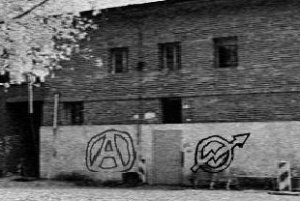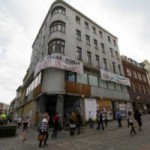 We are writing this short announcement with a bit of delay because we are technically unable and, because of all worries and obligations, short with time. We are looking back at a disaster that has befallen us as also the entire movement. A disaster in the shape of a huge poison of this society which stings even more when the executor of the same are big ”anarchists” and ”antifascists”.. or better, ”comrades”. The poison is indifference (which implies to not-giving-a-shit, parasitism, insensitivity, malice) which allows an individual to do all sorts of abominations without any real reason. [Read More]
We are writing this short announcement with a bit of delay because we are technically unable and, because of all worries and obligations, short with time. We are looking back at a disaster that has befallen us as also the entire movement. A disaster in the shape of a huge poison of this society which stings even more when the executor of the same are big ”anarchists” and ”antifascists”.. or better, ”comrades”. The poison is indifference (which implies to not-giving-a-shit, parasitism, insensitivity, malice) which allows an individual to do all sorts of abominations without any real reason. [Read More]
Zagreb: the only squat in Croatia endangered because of an ”anarchist”?
Pizzeria Anarchia Vienna
The Pizzeria Anarchia is a house project located at the Mühlfedgasse 12 in the second district in Vienna. It exist since November 2011 and is now in danger of eviction. At that time, the two owners of the house, Avner Motaev and Nery Alaev, owners of Castella GmbH, offered a temporary use free of charge, first until March, later until June 2012. Even though they claimed to be motivated by social responsibility, it became quickly obvious that their real motivation (which they admitted in front of the judge by now) was to scare away the remaining tenants. Due to their permanent rent contracts, it was nearly impossible to displace them by juridical means, and they also couldn’t be persuaded to move out by the sabotage and intimidations made by the owners.
[Read More]
Zurich : BINZ, after May 31st the Binz squat is in threat of eviction
 After May 31st the Binz squat is in threat of eviction. The Canton Zurich wants to tear down the former factory buildings as soon as possible and pass over the property to ‘Stiftung Abendrot’ by spring 2014.
After May 31st the Binz squat is in threat of eviction. The Canton Zurich wants to tear down the former factory buildings as soon as possible and pass over the property to ‘Stiftung Abendrot’ by spring 2014.
AGAINST DEMOLITION IN ADVANCE
The beginning of the construction is planned for October 2014 and the project for the construction from ‘Stiftung Abendrot’ is still in planning.
That’s why:
We want to and we have to defend and preserve every alternative living space.
Call for creative resistence against the tearing down of the squatted factory Binz.
We don’t wish escalation provoked by Binz.
Come by and rock the BINZ.
We start with Vokü (people’s kitchen) on May 17th 20 [Read More]
Amsterdam (The Netherlands): May 2013 Joe’s Garage Program
Welcome to post gentrification. Forget about affordable housing, these words are gone from the vocabulary. In Amsterdam, the price per meter square is higher in social housing than on the market price. Tenants are waiting in temporary housing for a proper one. These anti-squatters, also called “guardians” to preserve their image, haven’t been given the rights of a normal tenant. They even pay to guard houses. Not only young people and students live in this precariat. Anti-squat companies have seen their benefits exploding in recent years, while former social housing corporations have been cashing big money and forgotten since long about their social purpose.
People who can’t afford to live in the city have to go. They are denied the right to live in the city, they are made feeling guilty and ashamed of being social tenants. Our policy makers want people to move around in this monetary driven housing market. Social dramas on individual scales are common, people can’t sell back their house, the money they make is used to pay back mortgages. In Germany, a group like Recht Auf Stadt put back these issues on the political agenda. Some political parties have now an opinion about that. In the Netherlands, the discourse is still the same, “there is no problem”. SNS nationalised, the Russian roulette game has reached money lender Rabobank. For how long? [Read More]
[Read More]
Lewes (UK): Sussex squat project
This week for Mayday a group of squatters opened a community centre in Lewes as part of the ‘Stop the G8’ anti-capitalism movement. The centre has an organic, locally grown, donations based vegetable shop, a comfy tea room, a well stocked free shop, and a sunny garden.
Everyday workshops are being held on things such as Fracking and extreme energy, Combe Haven defenders, stop the G8, Hunt sabbing etc.
[Read More]
[Spain] This is not a demonstration – Actions, constructions and revolutionary turns to save the world
From : http://takethesquare.net
In the past two years we have completely reinvented the way we try to transform the world into a place where life does not hurt. The old demonstrations, so grey and limited, become obsolete and useless, and have given way to an infinity of possibilities. We rethought the action, the complaint, the relationships, the public, the common, and our imagination has completely overwhelmed the space of what is possible, building already new worlds inside the old structure of this one. We collect here a list of dozens of actions and constructions that we have organized during these two years, sharing all of them that brightness of the new, that smell so special that returns us the confidence in us, and announces what is to come. We hope you enjoy them as much as we do.
London, May 12th: NO Evictions! Campaigning and Protest in the Context of the Housing Crisis
Today, many people are facing eviction because of the unfair welfare changes which will force people into debt and arrears. How can we campaign to keep people in their homes? Join us for an afternoon of housing related discussion, international skill sharing, developing ideas for creative protest action and networking!
Dublin: Successful anti-eviction defence
Around lunchtime on April 15th we received word that there was an anti-eviction protest underway on Manor street in Dublin outside a house that had been squatted. A Garda had called at the door that morning and after being refused entrance had said he’d be back later with more Garda. The building had been squatted on and off a couple of times in recent years and was recently re-occupied.
[Read More]
ACT UP/San Francisco Protests Evictions: Housing=Healthcare And Eviction=Death
In celebration of their one year anniversary, the direct action group ACT UP/San Francisco staged a lively, 50 person demonstration last Saturday, April 20th. The event was aimed at drawing attention to the impact of increasing evictions and rental price increases in San Francisco on people living with HIV/AIDS. The group, and a coalition of supporting LGBT and housing rights organizations, began at 16th and Mission Street and worked their way up to Harvey Milk Plaza in the Castro. The marchers, who took to the streets chanting ‘Housing is a right, housing is a right, ACT UP!’ and ‘Housing equals healthcare and eviction equals death!’, made multiple stops along the way. Though perhaps small in size, the demonstration made a strong and colorful stand, one that hammered in the point that the increasing rents and waves of evictions hitting San Francisco hurt people living with HIV/AIDS and their supporters. Despite the inclusion of lavish street theater and brightly painted signs, the protest was not all noise. Imbedded in their style, ACT UP offered a pointed critique of San Francisco’s City government, especially District 8 Supervisor Scott Wiener, a gay man who the group feels has turned a blind eye to evictions in his neighborhood.
Poznan (Poland): Odzysk squat, the opening!
On 26-27/04/2013 we opened for public Od:zysk [Re:claim] squatted social house in the strict center of Poznań, western Poland. That’s the second squatted autonomous space in the city, next to Rozbrat squat, in part thought of as the reincarnation of Warsztat [The Workshop] squat, evicted last year.
Our agenda is to inspire social change, tame the gentrification process in the Old Market Square with non-commercial, anticapitalist action, politically oriented art, culture, workshops, supplying a venue for unconstrained political debate and living space for a dozen of people, organized independently and self-sufficiently. [Read More]
Basildon (UK): Dale Farm Protestor Awarded Damages For Police Detention
Lausanne: Interview with the collective la LOC(A)MOTIVE
New News: Since 8 April 2013 the squat is in danger of eviction. The members of the house will struggle against that. Support us if u want. Infos will follow.
Below is an interview with participants in the Loc(A)motive squat that was made possible on the occasion of counter-information gatherings in Lausanne. Since April 8th, Loc(A)motive is in danger of eviction, and the squatters are organizing a defense of the house. So, this would be the time to support them in any way you want.
Contra Info: What is the Loc(A)motive?
Loc(A)motive: It is a collective composed of people living in the occupied house of 1, Chasseron, in Lausanne, as well as people involved in the space’s activities. At the moment, 15 individuals are living in the house, and more or less 10 are also participating in different ways. The building is a former Spanish college, property of the Spanish State.











